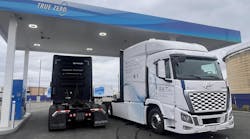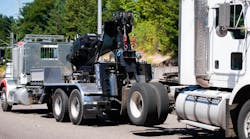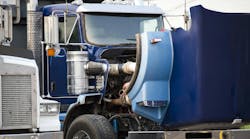Idling a truck's engine was once the only way a driver could control the temperature in the cab/sleeper and have power for auxiliary devices when the truck was parked. Sure, it was a dirty, noisy business and every truck wasted thousands of gallons of diesel per year going absolutely nowhere, but that was the way it was.
Now, even though there are more than two dozen different alternatives to idling commercially available, that dirty little habit hangs on. If your company hasn't given up idling, this is the perfect time to shop around for the alternative solution that will best fit your operation. Here are some of the options available today.
GENERATORS AND APU'S
Auxiliary power generators and APUs (auxiliary power units) are not really the same, although the terms are sometimes used interchangeably. Generators, powered by 1-, 2-, 3- or 4-cyl. diesel engines, produce electricity to run AC-powered devices, from heaters and air conditioners to microwave ovens. Many suppliers also offer an AC power-plus-climate control package and DC battery charger functionality.
APUs, on the other hand, typically include an engine, compressor and alternator, and are fully integrated into the truck's own HVAC system to provide climate control, battery charging and engine heating. The addition of an inverter/charger allows APUs to work as a source of AC power as well.
One of the chief benefits of both generators and APUs is their portability. Because the systems are truck-mounted, they can be used virtually anywhere. Those who favor generators say they like the idea of a self-contained system that can be installed without touching a truck's own HVAC system. Fans of APUs, on the other hand, like the idea of using the original factory-installed HVAC system and controls, rather than adding additional heating and cooling equipment.
The AXP 1000 auxiliary power generator from Energy & Engine Technology Corp., for example, is run by a 4-cyl., air-cooled 7.5-hp. Lombardini diesel engine that conforms to current Clean Air Act and CARB standards. The generator set produces 5kW AC current at 120 volts continuous plus 40 amps DC power. A variety of heater and air conditioner options can be paired with the system and are available as a package.
“All we do is generate electricity,” explains CEO Will McAndrew III, “and we do that very efficiently, burning only about 1.2 pints of diesel per hour as opposed to the more than a gallon per hour an idling truck engine consumes. There is no ‘standard’ AXP unit because there is no standard truck, but our adjustable carriage assembly permits it to be mounted almost anywhere.”
Teleflex Canada makes an auxiliary power and climate control system called the Proheat Gen 4. Powered by a 13.9 hp., 2-cyl.- Kubota engine, it is designed to provide 4,000 watts of 115-volt household AC current, 10,000 Btu/hr of heating and 12,000 Btu of cooling, plus truck engine heating and battery charging, according to Mengo McCall, manager of western regional sales for the company. “We design, assemble and market the entire system ourselves, from the gen set to the heater and air-conditioner units,” he notes.
TruckGen of FL also makes diesel-powered generator sets designed to provide 120-volt AC power and 12-volt DC power. According to Klaus Holze, sales director for TruckGen, the demand for their battery box- enclosed auxiliary generators has “never been better.”
The Pony Pack APU, now available as an option from Volvo Trucks North America, is an example of a “true” integrated APU. It utilizes a Kubota 2-cyl. 10.8-hp. engine and an A/C compressor to operate the truck's existing HVAC systems and provide 12-volt DC electricity (and a 110-volt inverter) to operate truck accessories when the truck's engine is off.
In 2002, EPA published a study comparing fuel use and emissions at idle for several heavy-duty truck engines and two idle reduction devices, including the Pony Pack APU. “The data showed that our unit provided very significant reductions in fuel consumption,” says Rex Greer, company president. “The 2000 Pony Pack was also found to be capable of reducing NOx emissions by 89% to 96% and CO2 by 52% to 81%.”
Double Eagle Industries has also developed an APU to meet the power needs of their super-sized Double Eagle sleepers, according to Ray Miller, president and owner. Their Gen-Pac is powered by a 3-cyl., 18-hp. engine pre-set to run at 1800 rpm, he notes, putting out a steady 5,000 to 7,000 watts of DC power.
Another APU option is offered by Auxiliary Power Dynamics. “We can run everything on the truck now except the driveshaft,” says Eldon Willis, COO. “Our baseline APU includes a 3-cyl. diesel engine, alternator, A/C compressor and coolant circulation through a heat exchanger, but we also offer a number of options, including an oil pump, air compressor, air starter and 2,500-watt inverter.
“We've gone to a microprocessor controller,” he adds. “This makes the system fully automatic. When the driver sets the parking brake, the APU starts and the truck engine is programmed to shut down.”
NO-IDLE HEAT AND A/C
For fleets and drivers that idle primarily to keep the cab and sleeper at a comfortable temperature and the engine ready to start, there are a variety of options available designed to provide heat, air conditioning or both. Some units run on diesel. Others run on DC electrical power from batteries and/or on AC power, either externally supplied shorepower or from a batteries-plus-inverter system.
Webasto Product North America, for instance, offers fuel-operated heaters for engines, cabs and cargo-space heating. The Air Top 2000 sleeper heater and new Tandem Kit Air Top 2000, which includes a small engine pre-heater unit, have been the company's most popular products, according to Don Kanneth, director of sales services for Webasto's heavy-duty OEM and aftermarket group. “Our Air Top can run 20 hours on a gallon of fuel,” he says.
Espar Heater Systems offers a diesel-fired bunk heater, the Airtronic 2, and an engine pre-heater, the Hydronic 5. Espar's heater may be combined with one of two electrically driven air-conditioning units to provide no-idle heating and air-conditioning. “The Airtronic 2 burns .03 to .07 gal./hr. to produce 2,900 to 7,500 Btu/hr. It doesn't take much to do that math,” says John Dennehy vp-marketing for Espar.
The DC-powered, hermetically sealed NITE air-conditioner unit from Bergstrom has its own batteries, air distribution system, and power control system, according to Terry Zeigler, director of new product development. “Our two, six-volt, deep-cycle batteries in series are designed to operate up to 10 hours between charges.” he says.
Still another climate control choice is the heating/cooling option from Cab Comfort, a division of Dometic. The Duo-Therm compressor-driven heat-pump system is run entirely on AC electricity, externally supplied or from the Kwyatt Power battery/inverter system or onboard generator.
“Our unit is designed specifically for rest periods in the sleeper,” says Pat McConnell, director of quality, safety and standards for Dometic and program manager of the Cab Comfort Commercial Products Group.
ENGINE-BASED SYSTEMS
Fleets that want to reduce engine idling with no additional equipment of any kind are looking to engine makers for solutions and finding a number of options. Detroit Diesel Corp., for example, offers four idling management capabilities, including Optimized Idle, an option on its Series 60 engines, according to Tom Diefenbaker, director of electronic product business development.
“Idle shutdown is a standard engine feature,” Diefenbaker says. “When the parking brake is set, the engine can be programmed to shut down automatically after two to 100 minutes.
“Optimized Idle is a patented system designed to monitor the engine temperature, cab temperature and battery voltage and then stop and start the engine when the truck is parked as necessary,” he explains. “In overnight idle situations, it reduces idling time by about 50%.”
Cummins Engine Co. also offers a number of idle management tools, according to Clifford Putterill, marketing product leader for heavy-duty automotive. Idle shutdown is standard on all engines, he notes, and the ICON Idle Control Technology and Cab Comfort systems are available as options. “Engines leave the factory with the standard idle shutdown function set at 60 minutes,” he explains, “but it can be reset for any time between two to 1,440 minutes.
“The ICON Cab Comfort system is designed to automatically control engine starting and stopping when the truck is parked in order to reduce excess idle time, control the temperature in the cab and maintain the engine in a ready-to-start condition,” Putterill adds.
Caterpillar Engine Co. offers an idle shutdown timer as a standard feature on its electronic engines also. It can be programmed to automatically shut the engine off after 3 to 60 minutes of idling.
Caterpillar's Electronic & Electrical Systems division is also developing other non-engine based, idle-reduction solutions, according to David Orr, commercial manager for CAT's MorElectric technology, which grew out of a Dept. of Energy program. “The MorElectric System, which will be available in October 2005, provides an electric HVAC module to reduce fuel consumption, lower emissions and improve reliability,” he says. “A high-efficiency generator replaces the alternator to power the HVAC while on the road. Once you have this electric HVAC on-board, you can plug into AC shorepower or use our integrated APU instead of idling.” (www.cat.com/MorElectric.)
OFF-BOARD SOLUTIONS
As Orr notes, in addition to all of the onboard idle reduction solutions, trucks configured to permit the use of shorepower AC can simply “plug in” instead of idling wherever shorepower is available. IdleAire Technologies is also bringing an entirely “off-board” AC power solution to the marketplace that can be used by almost any heavy-duty truck.(See pg 32 for details.)
“Idling costs the trucking industry as much as $5 billion per year for fuel alone,” says David Everhart, sr. vp. strategic relationships for IdleAire. “It is a shame that so many people are waiting for the magic bullet, the perfect solution to end idling when the technology is here today.”


